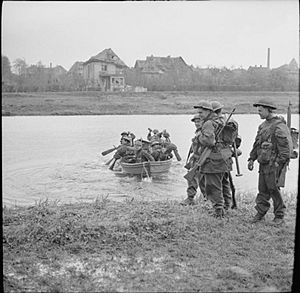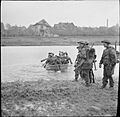157th (Highland Light Infantry) Brigade facts for kids
Quick facts for kids Highland Light Infantry Brigade157th (Highland Light Infantry) Brigade 157th Infantry Brigade |
|
|---|---|
| Active | 1902-1919 1920–1947 |
| Country | |
| Branch | |
| Type | Infantry |
| Role | Infantry Mountain Air Landing |
| Size | Brigade |
| Part of | 52nd (Lowland) Infantry Division |
| Engagements | First World War Second World War |
The 157th (Highland Light Infantry) Brigade was a special group of soldiers in the British Army. This group, called a brigade, was made up of infantry soldiers, meaning they fought on foot. The brigade bravely served in both the First World War and the Second World War. During these wars, it was part of a larger group called the 52nd (Lowland) Infantry Division.
Contents
How the Brigade Started
The 157th (Highland Light Infantry) Brigade began in 1902. It was first known as the Highland Light Infantry Brigade. It was formed from a group called the Volunteer Force, which was like a part-time army for people who volunteered to serve. Before this, it was part of the Glasgow Brigade.
The brigade was made up of different battalions, which are smaller groups of soldiers. These battalions were all part of the Highland Light Infantry (HLI) regiment.
What Units Were in the Early Brigade?
From 1902 to 1908, the Highland Light Infantry Brigade included these groups:
- 1st Volunteer Battalion, Highland Light Infantry, based in Garnethill, Glasgow
- 2nd Volunteer Battalion, Highland Light Infantry, based in Overnewtown
- 3rd (Blythswood) Volunteer Battalion, Highland Light Infantry, based in Glasgow
- 9th Lanarkshire Volunteer Rifle Corps, based in Lanark
- 5th (Glasgow Highland) Volunteer Battalion, Highland Light Infantry, based in Glasgow
- A special company for medical support, later for army services
The main office for the brigade was first in Hamilton, then in Glasgow. The first leader of the brigade was the officer in charge of the HLI districts. Later, Colonel R.C. MacKenzie, who used to lead the 1st Volunteer Battalion, took command.
Joining the Territorial Force
In 1908, the old Volunteer Force changed. It became the new Territorial Force (TF) as part of the Haldane Reforms. The Highland Light Infantry Brigade became part of the Lowland Division within this new TF.
Brigade Units in the Territorial Force
The brigade's structure changed slightly:
- 5th (City of Glasgow) Battalion, Highland Light Infantry
- 6th (City of Glasgow) Battalion, Highland Light Infantry
- 7th (Blythswood) Battalion, Highland Light Infantry
- 9th (Glasgow Highlanders) Battalion, Highland Light Infantry
The First World War
When the First World War started in August 1914, the Lowland Division, including this brigade, was quickly called up for full-time service. In May 1915, the brigade was renamed the 157th (1/1st Highland Light Infantry) Brigade. The division also became the 52nd (Lowland) Division.
Understanding the '1/' Prefix
The battalions added '1/' to their names, like 1/4th HLI. This was to avoid confusion with new "2nd Line" groups forming. These 2nd Line groups, like the 196th (2/1st Highland Light Infantry) Brigade, were made up of new recruits and those who didn't volunteer for fighting overseas right away. They were meant to be a backup for the main fighting units.
During the war, the 157th Brigade and its division fought in the Middle East. Later, they moved to the Western Front in Europe.
What Units Fought in World War I?
The brigade's makeup changed a bit during the war:
- 1/5th (City of Glasgow) Battalion, Highland Light Infantry
- 1/6th (City of Glasgow) Battalion, Highland Light Infantry
- 1/7th (Blythswood) Battalion, Highland Light Infantry
- 1/9th (Glasgow Highlanders) Battalion, Highland Light Infantry (left in November 1914)
- 1/5th (Renfrewshire) Battalion, Princess Louise's (Argyll and Sutherland Highlanders) (joined April 1915, left June 1918)
- 157th Machine Gun Company (formed March 1916, later joined the 52nd Battalion, Machine Gun Corps)
- 157th Trench Mortar Battery (formed June 1917)
Between the World Wars
After the First World War ended, the brigade and its division were temporarily stopped, like many other military groups. But in 1921, when the Territorial Army was created, the brigade was restarted. It was now called the 157th (Highland Light Infantry) Infantry Brigade.
It was again made up of the 5th, 6th, 7th, and 9th battalions of the Highland Light Infantry. This lasted until 1938.
Changes Before World War II
In 1938, the 7th Battalion, HLI, changed roles. It became part of the Royal Artillery to help with anti-aircraft defenses. It was renamed 83rd (7th (Blythswood) Battalion, Highland Light Infantry) Anti-Aircraft Brigade, Royal Artillery. Also, the 9th (Glasgow Highland) Battalion was renamed 1st Battalion, Glasgow Highlanders, but it was still linked to the Highland Light Infantry. The next year, the brigade was simply called 157th Infantry Brigade.
The Second World War

During the Second World War, the 157th Brigade served with the 52nd Division. In mid-1940, they went to France during Operation Aerial. Their job was to help cover the retreat of the British Expeditionary Force (BEF) as they were being evacuated from France.
From 1942 to June 1944, the division trained for mountain warfare, which is fighting in mountains. However, they never actually fought in this way. Then, they trained for airlanding operations, where soldiers are flown into battle. But again, they were not used in this role.
In October 1944, the brigade was sent to Belgium to join the 21st Army Group. They worked with the First Canadian Army and fought in the Battle of the Scheldt. In 1945, the brigade took part in Operation Blackcock. They ended the war near the River Elbe.
A famous soldier named James Cassels served with this brigade. He later became a very high-ranking officer, a field marshal, and the Chief of the Imperial General Staff. He was a brigade major with the 157th Brigade from May 1940 to October 1941.
What Units Fought in World War II?
The 157th Infantry Brigade was made up of these units during the war:
- 5th Battalion, Highland Light Infantry
- 6th Battalion, Highland Light Infantry (until February 12, 1945)
- 1st Battalion, Glasgow Highlanders (until March 12, 1945)
- 157th Infantry Brigade Anti-Tank Company (formed May 12, 1940, stopped January 7, 1941)
- 5th Battalion, King's Own Scottish Borderers (joined February 12, 1945)
- 7th Battalion, Cameronians (Scottish Rifles) (joined March 14, 1945)
On August 12, 1944, the brigade was organized as a "Brigade Group." This was for the 52nd (Lowland) Division's planned airlanding operations. The 157th Brigade Group traveled to Northwest Europe with extra units under its command:
- 52nd Reconnaissance Regiment, Royal Armoured Corps (for scouting)
- 79th (Lowland) Field Regiment, Royal Artillery (for artillery support)
- 304 Anti-Tank Battery, 54th (Queen’s Own Royal Glasgow Yeomanry) Anti-Tank Regiment, Royal Artillery (for fighting tanks)
- 354 Light Anti-Aircraft Battery, 108th Light Anti-Aircraft Regiment, Royal Artillery (for fighting aircraft)
- 243 Field Park Company, Royal Engineers (for engineering tasks)
- 17 Bridging Platoon, Royal Engineers (for building bridges)
- 529 Infantry Brigade Company, Royal Army Service Corps (for supplies)
- 76 Divisional Troops Company, Royal Army Service Corps (for supplies)
- 157 Field Ambulance, Royal Army Medical Corps (for medical care)
- 52 Field Maintenance Section, Royal Army Ordnance Corps (for equipment repair)
- Detachment 52 Divisional Ordnance Field Park, Royal Army Ordnance Corps (for equipment repair)
- 157 Brigade Workshops, Royal Electrical and Mechanical Engineers (for vehicle repair)
- Two Sections, 52 Divisional Field Provost Company, Royal Military Police (for military police duties)
These extra units went back to the division's command when the 52nd (Lowland) Division arrived by sea in October. They then took part in ground operations.
Who Led the Brigade?
These officers commanded the 157th Infantry Brigade during the war:
- Brigadier N.R. Campbell (until April 23, 1940)
- Brigadier Sir J.E. Laurie, Bart (from April 23, 1940, until March 30, 1941)
- Brigadier E. Hakewill Smith (from March 30, 1941, until March 22, 1942)
- Brigadier F.L. Johnston (from March 22, 1942, until November 22, 1943)
- Brigadier J.D. Russell (from November 22, 1943, until January 26, 1945)
- Brigadier E.H.G. Grant (from January 26, until July 24, 1945)
- Lieutenant-Colonel R.L.C. Rose (Acting, from July 24, 1945)
Images for kids
More Information
- Mark Conrad, The British Army, 1914 (archive site)
- The Long, Long Trail
- The Regimental Warpath 1914–1918 (archive site)


